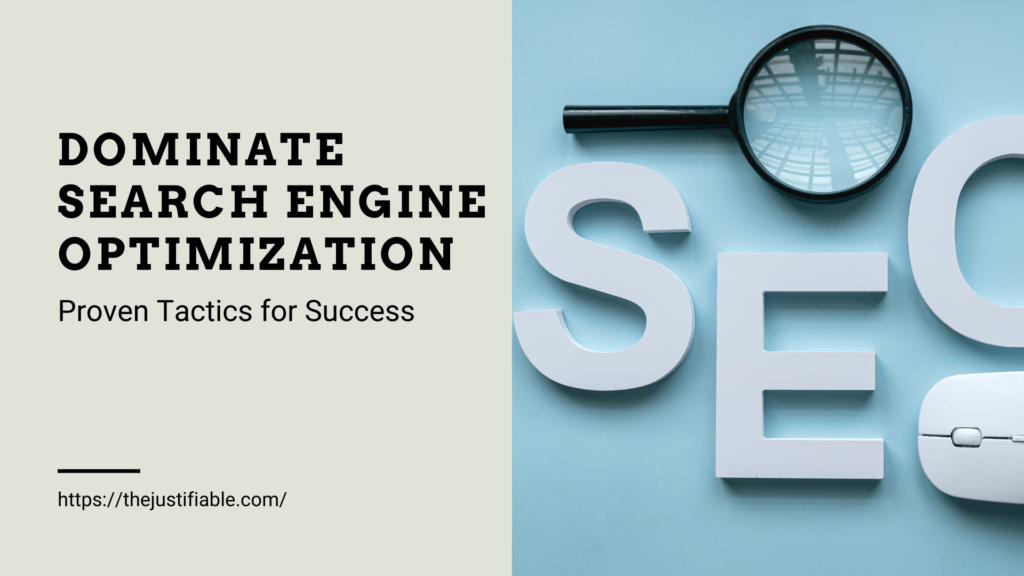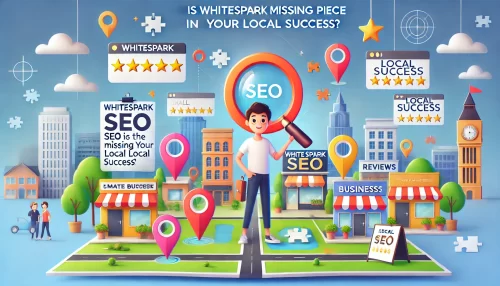Table of Contents
Are you struggling to rank higher on search engines? Wondering what proven strategies can boost your site’s visibility?
In this guide, we will answer these questions and explore practical tactics for dominating search engine optimization. From on-page SEO to building high-authority backlinks, these tips will help you optimize your content and climb the search rankings.
Mastering On-Page Search Engine Optimization Techniques
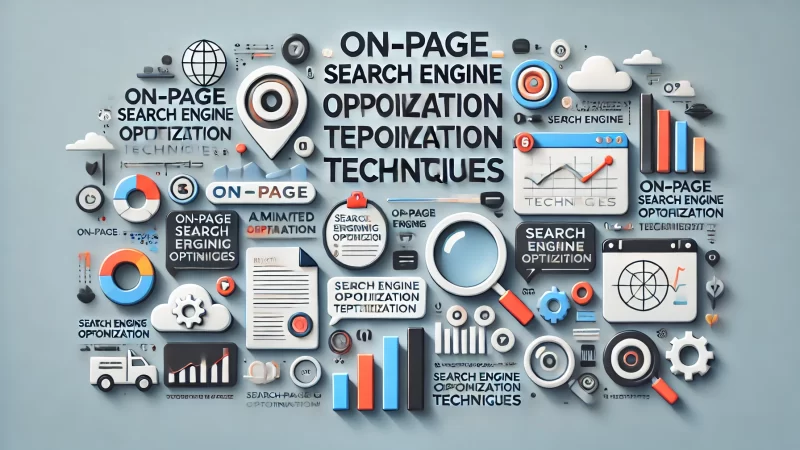
On-page SEO is crucial for improving your site’s visibility and ranking on search engines. It focuses on optimizing individual pages to ensure they are user-friendly, well-structured, and appealing to both users and search engines. Let’s dive into the core elements of on-page search engine optimization that help enhance your website’s performance.
Understanding Core On-Page SEO Elements
On-page SEO includes many factors that directly influence a website’s ranking. I know from experience that these elements, such as keyword usage, meta descriptions, and internal linking, help search engines understand the content on your page and assess its relevance.
By focusing on improving page titles, headings, and URL structures, you can make your website more readable and search-engine friendly. I suggest regularly reviewing these elements to ensure they align with SEO best practices.
Internal links help guide visitors through your content while showing search engines how different pages are related. I emphasize incorporating relevant internal links to boost engagement and assist in ranking specific pages.
You’ll also want to pay attention to mobile optimization, as search engines prioritize mobile-friendly sites. I believe that making your website accessible on various devices can positively impact both user experience and rankings.
Best Practices For Optimizing Meta Tags & Descriptions
Meta tags and descriptions are vital for telling search engines what your page is about. I recommend always crafting concise and keyword-rich meta descriptions that grab users’ attention and encourage them to click on your link.
Ensure that each page has a unique title tag that reflects the content while incorporating your primary keyword. I’ve found that well-optimized meta titles can significantly improve click-through rates and boost your ranking in search results.
In my experience, a descriptive meta tag should be between 150–160 characters, making it short but informative. A concise description helps search engines display relevant results for user queries.
Including action words in meta descriptions can increase engagement. When I create meta descriptions, I often use phrases like “Discover,” “Learn,” or “Explore” to captivate the reader’s attention and drive clicks to the page.
Structuring Content for User Experience and Search Engines
Content structure is key to both search engine optimization and user experience. I always break down complex topics into smaller, readable sections, making it easier for users to follow along and for search engines to understand.
Headings and subheadings guide readers through your content and make the page skimmable. I suggest using heading tags (H1, H2, H3, etc.) effectively to create a hierarchy within your content.
A well-structured page is not only easier for users to read but also helps search engines crawl and index your site more efficiently. In my experience, a clean structure improves overall engagement and site ranking.
Using bullet points or numbered lists helps organize your content and increases its readability. I find that readers are more likely to stay on the page if the content is neatly laid out and easy to navigate.
Optimizing Headings and Subheadings for Search Engines
Headings should serve a dual purpose: they guide readers and signal the topic of the content to search engines. I recommend always including your primary keyword in at least one heading on each page.
When optimizing headings, I focus on clarity and relevance. In my opinion, vague or unclear headings can confuse readers, so I always aim to make my headings straightforward and keyword-focused.
Subheadings (H3s and H4s) allow you to dive deeper into the subject without overwhelming the reader. I suggest using subheadings to structure content logically, making it easier to digest.
Keyword-rich headings are essential for SEO, but I advise avoiding keyword stuffing. Instead, focus on naturally integrating keywords into headings while maintaining a conversational tone.
Leveraging Keyword Placement for Maximum SEO Impact
Where and how you place keywords matters for SEO. I suggest using your primary keyword early in your content to signal its relevance to search engines, but also ensure that it flows naturally with the surrounding text.
One of my favorite strategies is to include the primary keyword within the first 100 words of your content. This reinforces its importance and makes your content more likely to rank for that keyword.
Using synonyms and related keywords throughout the content helps enhance SEO without overloading the page with the same term. I suggest adding these variations to boost your page’s relevance.
I’ve learned that you should strategically place keywords in headings, meta descriptions, and image alt text. These areas signal to search engines that your content is focused on a specific topic, helping you rank better.
Unlocking The Power Of SEO-Friendly Content Creation
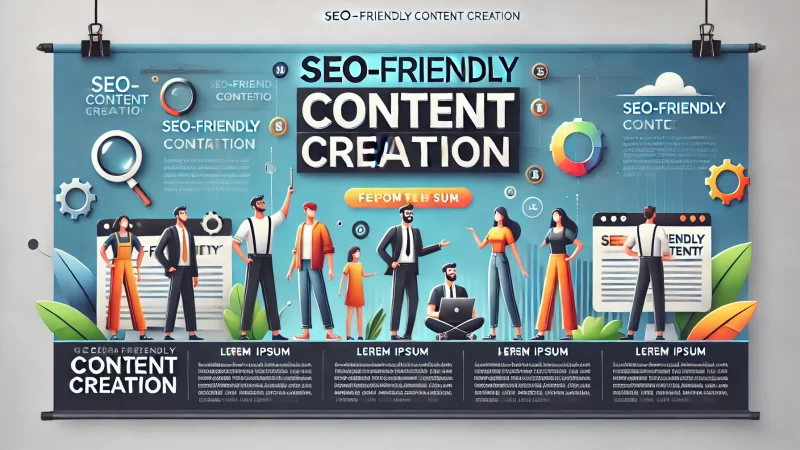
Creating SEO-friendly content goes beyond just including keywords. The focus should be on creating valuable, engaging, and informative content that appeals to both readers and search engines. Let’s explore how you can optimize your content creation process to enhance SEO performance.
Crafting Engaging and Keyword-Optimized Blog Posts
Writing blog posts that balance keyword usage and readability is key to effective SEO. I suggest using a conversational tone that keeps readers engaged while naturally incorporating your primary keywords into the content.
When I write, I focus on providing value to the reader. By answering common questions and offering practical insights, your blog posts will not only rank better but also encourage more engagement.
It’s important to use subheadings, lists, and images to break up text. I’ve found that visual elements can keep readers on the page longer, which helps signal to search engines that your content is valuable.
Your primary keyword should be present but not forced. I suggest reading your content aloud to ensure it sounds natural and doesn’t feel overloaded with keywords.
Incorporating Latent Semantic Indexing Keywords For SEO Boost
Latent Semantic Indexing (LSI) keywords are related terms that help search engines understand the context of your content. I recommend identifying LSI keywords relevant to your primary topic to improve your page’s visibility.
Incorporating LSI keywords allows you to cover a broader range of search queries. I often use these terms naturally throughout my content to strengthen the overall topic relevance without overstuffing the primary keyword.
These keywords help search engines recognize your content as comprehensive and informative. In my experience, using a variety of related terms signals to search engines that you’re addressing the topic in-depth.
Including LSI keywords in subheadings, image descriptions, and body text can help optimize your content without being repetitive. I’ve found that this method helps enhance ranking while keeping the content engaging.
Writing Long-Form Content To Improve Search Engine Ranking
Long-form content tends to rank higher in search engines because it provides in-depth information. I suggest writing articles of at least 1,500 words that thoroughly cover a topic, which helps search engines see your page as authoritative.
Longer content allows you to address multiple aspects of a topic, offering more value to the reader. From my experience, covering various angles in one piece of content can help boost time on page, signaling quality to search engines.
By including different subtopics within one post, you can target a broader range of keywords. I recommend writing content that answers multiple related queries, increasing the chances of ranking for more terms.
While long-form content is valuable, I advise breaking it up with headings, images, and lists to avoid overwhelming the reader. Keeping the structure clean and navigable improves user experience and SEO.
Avoiding Keyword Stuffing and Focusing On Quality Content
Keyword stuffing can harm your SEO by making content feel unnatural. Instead of repeating keywords excessively, I suggest focusing on creating high-quality, informative content that naturally incorporates relevant keywords.
In my experience, content that prioritizes quality over keyword density tends to perform better. Readers value insightful and engaging information, and search engines reward content that meets user needs.
I’ve noticed that search engines are smart enough to understand context, so there’s no need to force keywords into every sentence. I advise using variations and synonyms to keep the content flowing naturally.
Focus on delivering value, and the keywords will naturally fit into the content. I find that when I prioritize the reader’s experience, the SEO results follow organically.
Utilizing Visual Content For Higher Engagement And SEO Value
Visual content such as images, videos, and infographics can significantly enhance user engagement. I recommend adding relevant visual elements to your content to break up text and provide a more interactive experience.
Using descriptive alt text for your images helps improve SEO. I suggest including your primary keyword in at least one image alt text to signal to search engines what the image and content are about.
Infographics and charts can make complex information more digestible for readers. I love using these tools to help illustrate data or explain processes, which can encourage users to spend more time on the page.
Videos embedded within content can improve engagement rates. From my experience, users are more likely to stay longer on a page with multimedia, which helps improve SEO ranking by signaling content relevance and quality.
Proven Link Building Strategies For Better Search Visibility

Building high-quality links is one of the most effective strategies to improve search visibility. I believe that leveraging smart link-building techniques can help your site gain credibility and boost its rankings in search engine results. Let’s dive into proven tactics to build valuable backlinks.
Earning High-Quality Backlinks From Authoritative Sites
Getting backlinks from trusted and authoritative websites can significantly enhance your site’s ranking. I suggest focusing on websites within your niche that have a high domain authority to ensure you’re gaining valuable links.
One way I recommend earning these backlinks is through creating exceptional, shareable content that people naturally want to link to. If you’re producing high-quality resources, people will recognize the value and reference your work.
Building relationships with influencers and industry leaders is another way I’ve found to earn backlinks. I often reach out with valuable insights or collaborate on projects, which leads to organic linking opportunities.
Participating in podcasts, interviews, or expert roundups is a fantastic way to earn high-quality backlinks. I suggest offering your expertise to increase your exposure and attract links from authoritative sites.
Best Practices For Outreach And Building Relationships
When it comes to outreach, I suggest focusing on building genuine connections rather than just asking for links. I’ve learned that a personalized and friendly approach always works better than cold, generic emails.
One method I advise is finding blogs or sites in your niche and offering something of value, like content collaboration or sharing useful insights. This helps build rapport and increases your chances of gaining a backlink.
I believe consistency is key in outreach. Follow up with people you’ve contacted and nurture those relationships over time. Sometimes a second email or a friendly nudge can make all the difference in getting that coveted link.
Always track your outreach efforts. I suggest using tools to organize your outreach campaigns and measure success rates, so you know which strategies work best and can improve future efforts.
Using Guest Blogging To Increase Organic Traffic
Guest blogging is a powerful tool for building backlinks and driving organic traffic. I often advise pitching guest posts to reputable blogs within your niche that have a strong readership. This not only boosts backlinks but also builds authority in your industry.
Make sure your guest post provides real value to the audience. I’ve found that high-quality, informative posts are more likely to be shared and referenced by others, leading to additional backlink opportunities.
Guest blogging also allows you to tap into the blog’s existing audience, which can increase traffic to your site. I recommend including a relevant call to action in your author bio to encourage readers to visit your website.
When I write guest posts, I always ensure that my primary keyword appears naturally within the content, but I never overdo it. This helps with SEO without making the post feel promotional or keyword-stuffed.
The Importance of Internal Linking For SEO Success
Internal linking is crucial for SEO because it helps search engines understand the structure of your website. I suggest adding internal links that connect relevant pages to boost engagement and improve your site’s crawlability.
One of the strategies I use is linking to cornerstone content—pages that are fundamental to your site. I find this helps both users and search engines easily navigate to your most valuable pages.
Internal linking also allows me to pass authority between different pages. I often use it strategically to boost the ranking potential of newer or less-established pages on my site.
In my experience, adding internal links also reduces bounce rates. When readers have easy access to related content, they tend to stay on your site longer, which signals value to search engines and improves overall rankings.
Avoiding Common Backlinking Pitfalls To Maintain Rankings
Building backlinks requires caution because not all links are beneficial. I advise avoiding low-quality or spammy backlinks, as these can negatively impact your site’s ranking. I’ve seen sites penalized for participating in link schemes.
I’ve learned that buying links from untrustworthy sources can do more harm than good. I suggest focusing on earning organic, high-quality backlinks through ethical practices like content marketing and relationship-building.
Anchor text is another area where I suggest being careful. Over-optimized anchor text with exact-match keywords can look unnatural to search engines. I often advise using natural-sounding variations to avoid penalties.
Regularly auditing your backlink profile is crucial. I recommend using tools to monitor your backlinks and disavowing any harmful links that may drag your site down in search engine rankings.
Harnessing The Power Of Local Search Engine Optimization
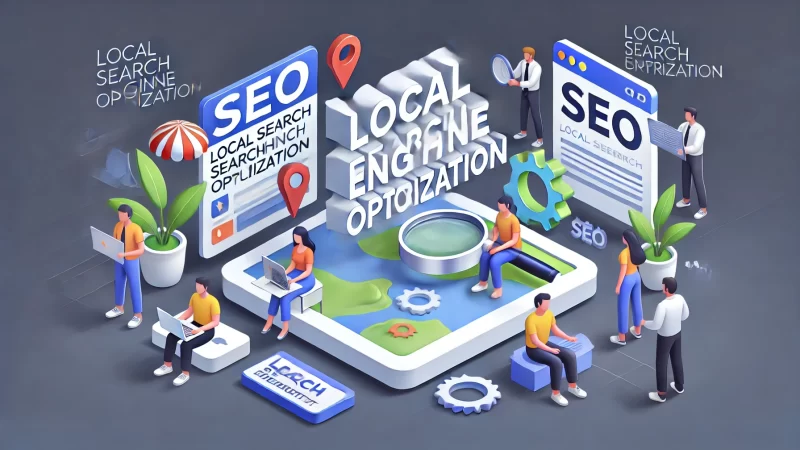
Local search engine optimization (SEO) is essential for businesses targeting nearby customers. I believe optimizing your local SEO can help your business become more visible to users searching for services or products in your area. Here’s how you can maximize your local presence.
Optimizing Google My Business For Local SEO Dominance
Your Google My Business profile plays a critical role in local SEO. I advise ensuring that your business name, address, and phone number (NAP) are consistent and accurate across all platforms to avoid confusing search engines.
I’ve found that adding high-quality images and keeping your profile updated with business hours, services, and descriptions makes your listing more attractive. I also suggest actively responding to customer reviews to show engagement.
I recommend using your primary keyword in your Google My Business description, as this can help boost local search rankings. Make sure the content feels natural and doesn’t come across as keyword-stuffed.
When I optimize my profile, I focus on adding relevant categories and ensuring the map pin is correctly placed. This helps Google show your business to people searching for services in your area.
Managing Online Reviews To Improve Local Search Results
Positive reviews can significantly improve your local search rankings. I suggest encouraging satisfied customers to leave reviews on your Google My Business profile and other platforms to build credibility and trust.
Responding to all reviews, both positive and negative, is important. I believe showing that you care about customer feedback enhances your business’s reputation and signals engagement to search engines.
I’ve learned that asking customers for reviews soon after a positive experience increases the likelihood of them leaving one. You can send follow-up emails or ask in person to make the process smoother.
Too many negative reviews without responses can hurt your local SEO efforts. I always advise responding professionally to complaints and trying to resolve the issues publicly to show prospective customers you value their feedback.
Local Citation Building: Why It Matters For Local SEO
Citations are mentions of your business across the web, and I believe building accurate local citations can improve your visibility in local search results. I recommend ensuring your business information is consistent across all citations to avoid confusing search engines.
There are many local directories where you can build citations. I often suggest listing your business on platforms like Yelp, Yellow Pages, and industry-specific directories for increased exposure.
Consistent citations build trust with search engines, as they reinforce your business’s legitimacy. I’ve noticed that businesses with numerous citations tend to rank higher in local searches.
In my experience, it’s essential to periodically check and update your citations. I suggest reviewing them for accuracy every few months to ensure your information stays current and reliable.
Creating Location-Specific Content To Capture Local Traffic
Content tailored to your local audience can drive more relevant traffic to your website. I often advise creating location-specific blog posts, guides, or case studies that mention local landmarks, events, or news.
When I write content for local SEO, I always include my primary keyword along with geographic terms. This helps search engines recognize the location relevance of your content and boosts your ranking in local search results.
I find that partnering with local businesses for joint blog posts or social media collaborations can also boost visibility. Featuring local collaborations helps your content resonate with the community and improves local engagement.
Using testimonials from local customers in your content adds authenticity. I suggest highlighting real customer experiences, which not only build trust but also contribute to your site’s local SEO efforts.
Utilizing Schema Markup For Enhanced Local Search Listings
Schema markup can help search engines understand the content on your site better, which improves how your business appears in search results. I recommend adding a local business schema to highlight important information like your business name, address, phone number, and hours.
Using schema markup, I’ve found that it makes it easier for search engines to display your business information in rich snippets, improving click-through rates and local search visibility.
You can also add a review schema to showcase your customer feedback directly in search results. I advise using this strategy to build credibility and attract more clicks from potential customers searching locally.
Make sure your schema markup is accurate and follows Google’s guidelines. I suggest testing your schema using Google’s structured data testing tool to ensure everything is properly implemented and error-free.
Effective Technical SEO Tactics To Boost Site Performance
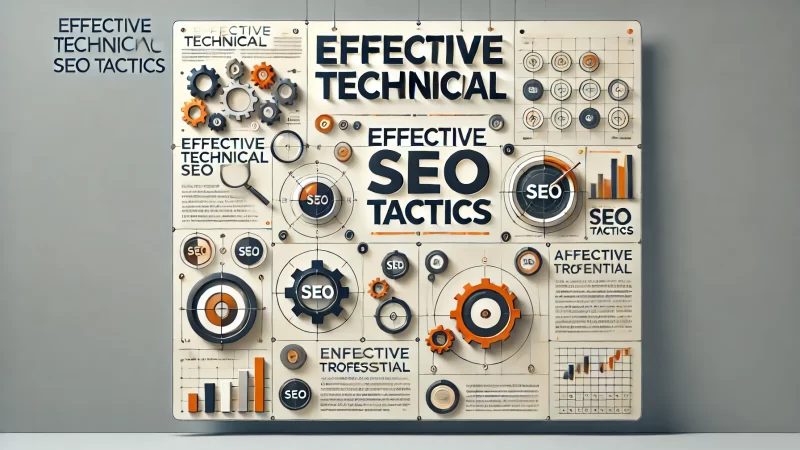
Technical SEO is the backbone of search engine optimization. I believe that focusing on technical elements ensures that your website performs well, providing a smooth user experience and making it easier for search engines to crawl and index your site. Let’s explore these key tactics.
Optimizing Website Speed For Better Search Engine Rankings
A fast website is crucial for both user experience and SEO. I always advise compressing images and using efficient coding practices to minimize load times, as slower websites often result in higher bounce rates and lower rankings.
Using a content delivery network (CDN) can speed up your website by delivering content from servers closer to the user. I’ve found that this strategy dramatically improves load times and helps maintain strong search engine performance.
Caching is another essential method for speeding up your site. I suggest enabling browser caching so returning visitors can load your site faster, which reduces load times and enhances user satisfaction.
I also recommend regularly testing your site speed using tools like Google PageSpeed Insights. This way, you can identify areas for improvement and make necessary adjustments to keep your site running smoothly.
Using Mobile-First Design For Enhanced Search Optimization
Mobile optimization is no longer optional; it’s a necessity. I suggest designing your website with a mobile-first approach, ensuring that your content is easily accessible and visually appealing on smaller screens to meet both user expectations and search engine preferences.
Responsive design is essential for mobile optimization. I’ve found that making sure your website adapts to various screen sizes can significantly improve user experience and boost your mobile search rankings.
Optimizing touch elements, like buttons and links, is another key factor. I advise ensuring they are easy to tap on mobile devices to enhance usability and prevent frustration for users navigating your site.
I suggest testing your website on different mobile devices to ensure it performs well across all platforms. This allows you to spot any design or functionality issues that might hurt your search rankings.
Improving Crawlability And Indexability Of Your Site
Search engines need to crawl and index your site efficiently to understand and rank your content. I recommend creating a well-organized XML sitemap to guide search engines through your pages, ensuring everything important gets indexed.
I often advise using internal linking to help search engines crawl your website more effectively. By linking to other relevant pages within your site, you create a clear structure that enhances both user navigation and crawlability.
I also suggest regularly checking for broken links and fixing any errors. Broken links can disrupt the crawling process, so ensuring all links work properly helps search engines move through your site without issues.
Using robots.txt is another tactic I advise to control which parts of your site search engines can access. This allows you to block low-value pages from being crawled, improving your overall SEO performance.
Implementing HTTPS For Secure And SEO-Friendly Websites
Security is a major ranking factor for search engines. I recommend migrating your website to HTTPS if you haven’t already, as search engines prefer secure sites and users trust them more, which can lead to higher engagement.
Having an SSL certificate installed is essential for establishing a secure connection. I’ve found that sites with HTTPS are favored in search rankings, as this protocol ensures that data between the user and server is encrypted.
Search engines may flag non-secure sites as unsafe, deterring potential visitors. I suggest regularly checking that your SSL certificate is functioning properly to avoid penalties and ensure ongoing trust with your users.
Using HTTPS not only boosts security but also builds credibility. I advise displaying your secure status visibly, like with a lock symbol in the browser bar, as this reassures users that their data is safe.
Eliminating Duplicate Content To Avoid SEO Penalties
Duplicate content confuses search engines and dilutes your SEO efforts. I suggest regularly auditing your site for duplicate pages or content blocks and consolidating them to ensure search engines can accurately rank your site.
Canonical tags can help resolve duplicate content issues. I recommend using them to indicate the preferred version of a page, guiding search engines to the correct content and avoiding penalties for duplication.
When updating content, I advise refreshing existing pages rather than creating new ones for the same topic. This keeps your SEO efforts focused and prevents confusion between similar pages.
I suggest using tools like Copyscape to check for any unintentional duplicate content across the web. If you find your content being copied elsewhere, you can take action to resolve it and protect your rankings.
Measuring And Analyzing SEO Results For Continuous Improvement

Regular analysis of your SEO performance is essential for long-term success. I’ve found that reviewing data helps identify what’s working and what needs adjustment, allowing you to refine your strategy and stay competitive in the ever-changing SEO landscape.
Utilizing Google Analytics To Track SEO Performance
Google Analytics is one of the best tools for tracking your SEO performance. I suggest setting up goals to measure conversions and using the data to identify which pages are driving the most traffic and engagement.
You can track organic traffic to see how your SEO efforts are paying off. I recommend regularly reviewing which keywords and pages are performing best, so you can focus on optimizing these for even greater results.
Bounce rate is another key metric to monitor. I’ve noticed that high bounce rates can signal poor content or user experience, which may negatively affect your SEO. I suggest analyzing this data to pinpoint and improve weaker pages.
I also advise using Google Analytics to track user behavior, such as time on page and click-through rates. This helps me understand how visitors interact with my site, guiding my strategy to optimize content and boost SEO.
Key SEO Metrics To Measure Success And Make Data-Driven Decisions
When measuring SEO success, I focus on key metrics like organic traffic, keyword rankings, and backlinks. I recommend tracking these metrics over time to gauge how your SEO efforts are impacting your overall visibility.
Monitoring conversion rates helps you understand how effectively your site turns visitors into customers. I suggest setting up conversion tracking in Google Analytics to measure the real impact of your SEO on your business goals.
I find that tracking the number of pages indexed by search engines is essential. If your pages aren’t being indexed, they won’t appear in search results. I suggest regularly checking your site’s index status to ensure search engines are crawling your content.
Analyzing backlinks gives insight into the strength of your site’s authority. I recommend keeping an eye on both the quantity and quality of backlinks, as this is a significant factor in improving your search engine ranking.
Conducting Regular SEO Audits To Identify Optimization Opportunities
SEO audits help identify optimization opportunities and fix potential issues. I suggest performing regular audits to check for broken links, slow-loading pages, and any crawl errors that might hurt your search engine ranking.
During audits, I often check metadata to ensure titles and descriptions are optimized. This helps boost click-through rates and improves how search engines display your pages in search results.
Auditing page speed is also important. I find that optimizing images, reducing script load times, and using browser caching can help improve site speed and provide a better user experience, which can positively affect your SEO.
I also suggest reviewing your site’s mobile performance during audits. As search engines prioritize mobile-friendly websites, ensuring your site looks and works well on mobile devices can significantly enhance your rankings.
Monitoring Competitors To Stay Ahead In Search Rankings
Understanding what your competitors are doing can provide valuable insights for your own SEO strategy. I often suggest analyzing competitor keywords, backlinks, and content strategies to identify areas where you can improve.
Using tools like SEMrush or SpyFu, you can track your competitors’ rankings and see where they outperform you. I recommend focusing on the gaps in their strategies and turning those into opportunities for your site.
I’ve found that monitoring competitor content helps me stay ahead. When I see a competitor covering a topic in-depth, I suggest creating even more valuable, thorough content to attract more traffic and rank higher.
Backlink analysis is another critical area to explore. I suggest identifying your competitors’ backlink sources and reaching out to these sites for opportunities to earn high-quality backlinks for your site as well.
Refining Your SEO Strategy Based On Performance Insights
Your SEO strategy should be flexible and data-driven. I recommend regularly reviewing your performance data and making adjustments based on what’s working and what’s not, so you can keep improving and stay competitive.
I believe it’s essential to focus on underperforming pages. By refreshing content, optimizing keywords, or improving the user experience, you can often revive traffic to these pages and enhance their rankings.
Another tactic I advise is revisiting old content and adding new, relevant keywords or updating information to keep it fresh. This signals to search engines that your site is up-to-date, which can improve its ranking potential.
I suggest continuously experimenting with new strategies, whether it’s testing different keyword focuses or tweaking page layouts. From my experience, staying proactive and responsive to your performance data helps you stay ahead in SEO.
Adapting To Search Engine Algorithm Updates For Long-Term Success
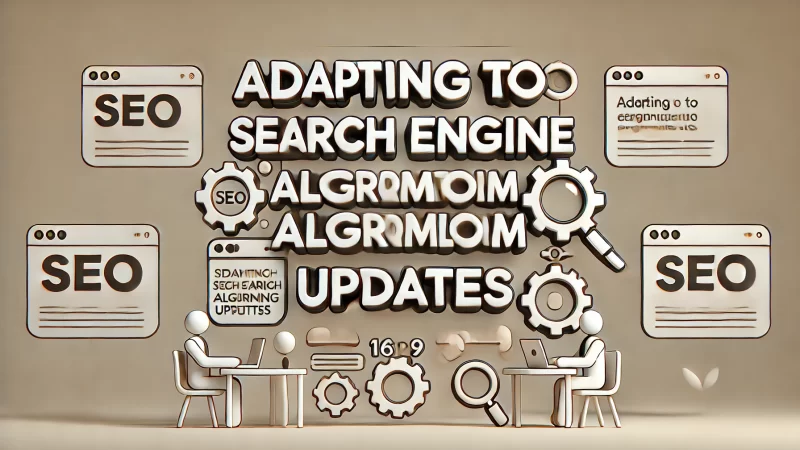
Search engine algorithms are constantly evolving, and adapting to these changes is critical for long-term SEO success. I suggest staying informed about updates and refining your strategies to maintain and improve your site’s rankings.
Understanding Major Search Engine Algorithm Changes
Major search engine algorithm changes can significantly impact website rankings. I recommend monitoring updates like Google’s core algorithm changes, which often focus on improving search relevance and quality.
I’ve found that focusing on high-quality content tends to protect your site from fluctuations during algorithm shifts. Search engines prioritize helpful, well-structured content, so ensuring your pages are informative can keep you on track.
Sometimes, algorithm updates prioritize user experience improvements, like page speed or mobile optimization. I advise keeping an eye on these trends to adjust your site accordingly and stay competitive.
I’ve noticed that older SEO tactics may become less effective with new algorithms. I suggest avoiding outdated practices, such as keyword stuffing, and focusing on more sustainable, user-focused SEO strategies.
How To Respond Quickly To Algorithm Updates And Maintain Rankings
Reacting quickly to algorithm updates is key to maintaining rankings. I advise keeping a close watch on your site’s performance through analytics, which helps identify any ranking drops early on and allows for prompt adjustments.
When a major update rolls out, I suggest conducting an audit to see how your site is affected. If rankings dip, I recommend adjusting the content, optimizing user experience, or enhancing technical SEO aspects like speed and mobile-friendliness.
I often review industry insights or advice from SEO experts after updates. This helps me understand the changes and refine my approach based on best practices, allowing me to align my strategies with the latest search engine priorities.
If rankings improve after an update, I suggest analyzing which elements worked well and applying those tactics across other parts of your website. Staying proactive with updates ensures long-term SEO success.
Keeping Up With SEO Trends To Stay Competitive
SEO is constantly evolving, and keeping up with trends can give you a competitive edge. I recommend following SEO news, blogs, and thought leaders to stay informed about shifts that might impact your strategy.
Emerging trends, like voice search optimization, are gaining popularity. I suggest optimizing your content for conversational queries and voice search to capture this growing segment of users and future-proof your SEO strategy.
As AI continues to influence search engine algorithms, I’ve noticed that search engines are getting better at understanding context. I recommend focusing on user intent in your content to align with how search engines interpret queries today.
It’s also important to test new approaches. I find that experimenting with new SEO tactics helps me stay ahead of competitors and understand what resonates most with both users and search engines.
Adopting White-Hat SEO Practices For Sustainable Results
White-hat SEO practices focus on ethical, long-term optimization strategies. I believe in building your SEO on high-quality content, keyword research, and user-friendly design, ensuring that your rankings are stable and sustainable.
Using ethical link-building tactics, like guest posting and earning backlinks naturally, helps establish your site as trustworthy. I suggest avoiding shortcuts like buying links, as they can harm your rankings in the long run.
Content creation is at the heart of white-hat SEO. I always recommend writing original, valuable content that solves user problems, as search engines reward pages that prioritize reader satisfaction.
I find that white-hat SEO practices are less likely to be penalized by algorithm changes. Focusing on providing real value to users allows you to build a long-term SEO strategy that won’t falter due to short-term tactics.
Avoiding Black-Hat Tactics That Lead To Search Penalties
Black-hat SEO tactics can offer short-term gains but often lead to penalties. I advise avoiding strategies like keyword stuffing, cloaking, or buying backlinks, as they violate search engine guidelines and harm your site’s reputation.
Search engines are quick to penalize sites using manipulative tactics. I’ve seen websites disappear from rankings due to black-hat methods, which makes it difficult to recover and regain credibility with search engines.
One common black-hat tactic I’ve encountered is using misleading redirects. Search engines see this as an attempt to deceive users, and I advise sticking to clean, transparent redirection practices that won’t raise red flags.
The best way to avoid penalties is to stick to honest, ethical SEO strategies. I suggest focusing on providing value to your audience rather than trying to manipulate search engines with quick-fix techniques.
Leveraging Social Signals To Strengthen SEO
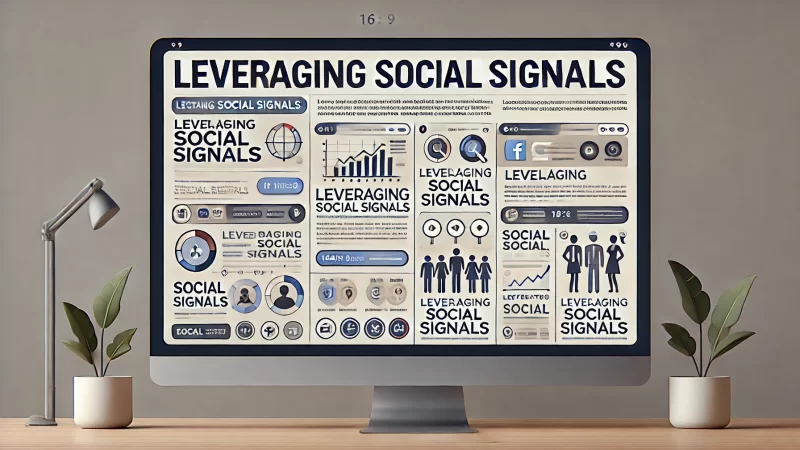
Social signals play an increasingly important role in SEO. I’ve found that a strong social media presence can indirectly impact search rankings by driving engagement, building authority, and attracting natural backlinks. Let’s look at how to harness the power of social media to support SEO.
How Social Media Presence Influences Search Engine Rankings
While social signals aren’t a direct ranking factor, I’ve noticed that strong social media engagement correlates with higher visibility in search results. When your content is shared widely, it reaches a broader audience, which can lead to more traffic and backlinks.
Social media profiles also often rank highly in search results. I recommend optimizing your social profiles with relevant keywords, clear descriptions, and links to your website to capture more search traffic.
I’ve found that sharing high-quality content on social platforms helps build brand awareness. As more users engage with your content, search engines see your brand as authoritative, which can indirectly benefit your rankings.
Social media engagement can also help boost your content’s visibility on search engines by driving more traffic to your site. I suggest regularly sharing blog posts, guides, and other valuable content to attract attention and improve traffic.
Creating Shareable Content To Drive Traffic And Engagement
Creating content that’s easy to share is key to driving traffic from social media. I suggest focusing on visually appealing content, like infographics or videos, as these tend to perform better across platforms and encourage more shares.
I recommend using clear calls-to-action in your posts, asking users to like, share, or comment. This helps boost engagement and can lead to increased visibility, which, in turn, attracts more traffic to your website.
Content that sparks discussions tends to get shared more often. I find that asking thought-provoking questions or sharing insights that challenge common beliefs can lead to higher engagement and more shares.
I also suggest integrating social sharing buttons on your website. This makes it easy for visitors to share your content directly from your site, driving even more traffic and engagement from their networks.
Utilizing Influencers To Enhance SEO And Brand Awareness
Collaborating with influencers is a great way to boost both SEO and brand awareness. I recommend identifying influencers within your industry whose audiences align with your target market, as their endorsements can drive significant traffic to your site.
When influencers share your content, it can reach a wider audience and attract high-quality backlinks. I find that these backlinks help boost your site’s authority in the eyes of search engines, which improves your rankings.
I suggest forming long-term relationships with influencers. Regular collaborations, such as guest posts or social media shout-outs, can keep your brand in front of their followers and drive ongoing traffic to your site.
Influencer marketing also helps establish trust. I believe that when users see influencers endorsing your brand, they’re more likely to view your site as credible and visit, engage, or share your content.
Building A Social Strategy That Supports SEO Goals
Your social media strategy should align with your SEO goals. I suggest creating a content calendar that integrates both your blog posts and social media updates to ensure your efforts are cohesive and mutually supportive.
Using relevant keywords in your social media content can help with SEO. I recommend incorporating keywords naturally into social posts, descriptions, and hashtags to improve visibility and reach the right audience.
I also suggest creating campaigns around your most important content. Promoting blog posts, case studies, or infographics through social channels increases their exposure, which can drive organic traffic and improve rankings.
I’ve found that consistency is key to building a successful social strategy. Regular posting and engagement on social platforms build brand awareness, increase traffic, and indirectly benefit your site’s SEO efforts.
Measuring The Impact Of Social Signals On Search Engine Optimization
Measuring social signals can help you refine your SEO strategy. I recommend using tools like Google Analytics to track how much traffic your social media efforts drive to your website and see which platforms are most effective.
Monitoring engagement metrics such as likes, shares, and comments gives insight into what content resonates with your audience. I suggest using this data to adjust your social media and content strategies for maximum impact.
Analyzing backlink growth from social campaigns is another way to measure success. I often check for natural backlinks generated from social shares, as this indicates that my content is being valued and shared by others.
I suggest keeping an eye on brand mentions across social platforms, as these can impact your brand authority and SEO. Consistent mentions signal to search engines that your brand is influential, which can enhance your search rankings.
Maximizing SEO With Paid Advertising And SEM Integration
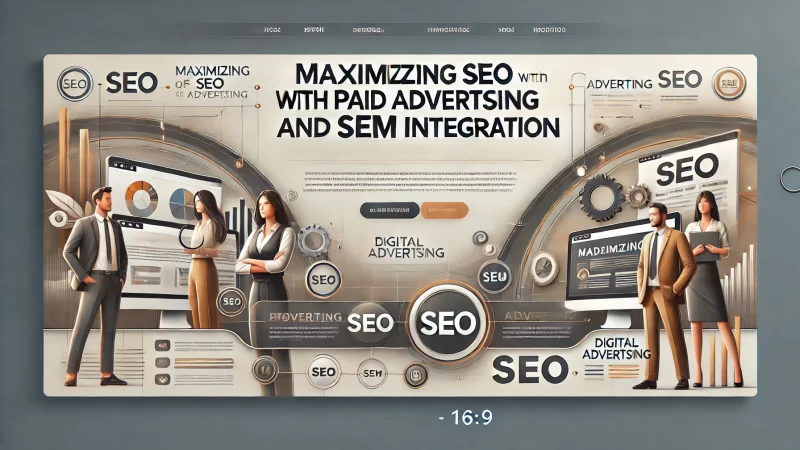
Combining SEO with paid advertising can significantly boost search visibility and overall website traffic. I recommend integrating SEO and SEM (Search Engine Marketing) strategies to create a balanced approach, enhancing both organic and paid traffic for optimal results.
Combining SEO And SEM For Maximum Search Engine Visibility
SEO and SEM work well together when done strategically. I often suggest using SEO to drive long-term, organic traffic while relying on SEM, such as Google Ads, for immediate visibility on search engine result pages (SERPs).
I’ve noticed that paid ads provide quick visibility while SEO builds authority over time. I recommend running SEM campaigns to promote key pages, especially when organic rankings need a boost or for new product launches.
With SEM, you can target keywords you may not yet rank for organically. I suggest this strategy for keywords with high competition, where gaining an organic position takes time but immediate traffic is crucial.
Combining efforts allows you to gather more comprehensive data. I’ve found that insights from SEM campaigns, such as high-performing keywords, can inform and refine your SEO strategy for better results.
Using Google Ads To Supplement Organic Traffic Growth
Google Ads can be a great tool for complementing organic traffic. I believe that running well-targeted campaigns allows you to capture traffic from users who might not find your site through organic search alone, especially during competitive periods.
I suggest setting up campaigns that focus on key products or services to capture high-intent traffic. This approach lets you control where your ads appear, driving relevant visitors to your site while supporting your SEO efforts.
Google Ads also provides immediate feedback through click data. I’ve found that analyzing this data helps you understand user behavior, which can improve both your SEO content strategy and ad targeting for better traffic results.
I advise using Google Ads to promote seasonal content or time-sensitive offers. This can attract a surge in visitors who may later convert into long-term organic traffic through email sign-ups or content engagement.
The Role Of Pay-Per-Click (PPC) In Supporting SEO Efforts
PPC campaigns play a crucial role in supporting SEO efforts. I recommend using PPC ads to enhance visibility for high-value keywords, particularly those that are difficult to rank for organically, allowing you to appear on page one quickly.
PPC can help increase brand awareness, which indirectly supports SEO by driving more traffic and engagement. I suggest combining SEO content with paid ads for terms where organic traffic is competitive but necessary for growth.
I’ve found that PPC is useful for A/B testing headlines and ad copy, providing quick insights that can inform SEO-focused content creation. Testing what resonates with users helps refine organic content for better performance.
PPC also boosts local SEO efforts. I often recommend running location-based ads to capture nearby customers. As they engage with your business, it builds local brand recognition and improves organic rankings in local search results.
Budgeting Effectively For SEO And SEM Campaigns
Balancing the budget between SEO and SEM is crucial for maximizing returns. I suggest allocating more resources to SEO for long-term growth while using SEM as a supplemental tool, especially during competitive or seasonal periods.
Start small with SEM to test what works. I often recommend setting a monthly cap to measure the effectiveness of campaigns, adjusting as necessary to maximize cost-efficiency without overspending on paid ads.
For SEO, I advise considering ongoing costs such as content creation, technical SEO, and link-building. These efforts take time to show results but offer a sustainable, long-term return on investment compared to PPC.
I’ve noticed that SEO costs tend to decrease over time as organic rankings stabilize, allowing you to shift more budget to SEM during competitive times or when launching new products, creating a balanced and flexible strategy.
Tracking ROI From Paid And Organic Search Efforts
Measuring the return on investment (ROI) for both SEO and SEM campaigns is essential for understanding what works. I recommend using tools like Google Analytics to track traffic, conversions, and sales from both organic and paid efforts.
I often compare the performance of SEO and SEM to see which channels are driving more qualified traffic. If SEM leads to more immediate conversions, it might signal a need to optimize SEO content for better targeting.
Using Google Ads reporting, I suggest tracking key metrics like cost-per-click (CPC) and conversion rate. This helps assess the cost-effectiveness of SEM campaigns, allowing for budget adjustments and better alignment with SEO goals.
I also advise looking at the long-term impact of SEO. Organic traffic tends to grow steadily over time, providing lasting value without ongoing costs. Regularly tracking organic growth ensures you’re meeting your SEO goals and justifying your investment.
Staying Ahead With Future-Proof SEO Strategies
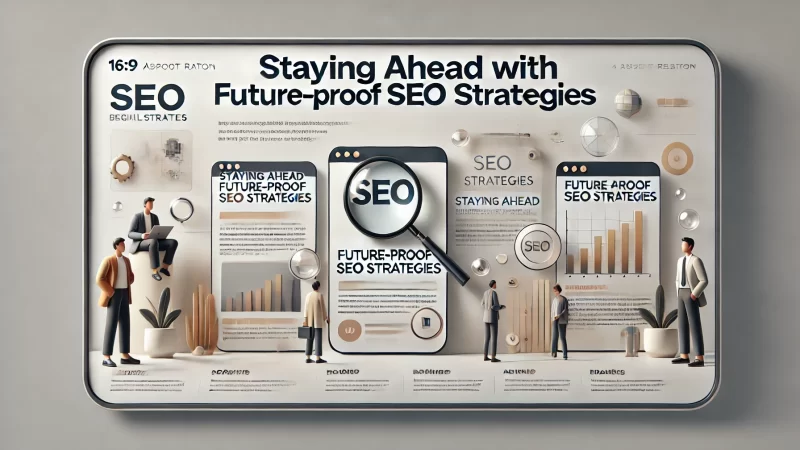
Future-proofing your SEO strategy is crucial in an ever-evolving landscape. I believe focusing on emerging trends like voice search and AI will help your site stay competitive and ensure long-term success in search rankings.
Preparing For The Future Of Voice Search Optimization
Voice search is becoming more popular, and I recommend optimizing your content for conversational queries. People tend to phrase voice searches as questions, so focusing on long-tail keywords and natural language is crucial for future SEO success.
I suggest implementing structured data to help search engines better understand your content. By using schema markup, your site is more likely to be featured in voice search results, especially for local searches or FAQs.
I’ve found that creating content that answers common questions helps capture voice search traffic. Organizing your content into a question-answer format makes it more accessible to voice assistants like Alexa or Google Assistant.
Optimizing for mobile is essential as most voice searches happen on smartphones. I advise ensuring that your website loads quickly and is user-friendly, which improves both mobile SEO and voice search rankings.
The Growing Impact Of Artificial Intelligence On SEO
Artificial intelligence (AI) is shaping how search engines understand content. I believe using AI-driven tools like RankBrain helps improve your SEO by focusing on user intent and content relevance, rather than just keywords.
I recommend creating high-quality content that satisfies user queries, as AI algorithms prioritize user satisfaction. From my experience, content that directly answers questions and provides value tends to rank higher.
AI also influences how search engines interpret and rank images, videos, and other media. I suggest optimizing visual content by using alt text and descriptive file names to make it easier for AI to understand your media.
I often advise leveraging AI-based SEO tools that analyze your site’s performance. Tools that provide insights into keyword ranking, site speed, and user behavior help streamline your optimization efforts and adapt to changing SEO landscapes.
Adapting SEO Strategies For Visual Search And Image Recognition
Visual search is becoming an important SEO factor. I recommend optimizing your images with relevant alt text, file names, and schema markup to ensure they’re easily searchable and help boost your site’s visibility in visual search engines.
Tools like Google Lens allow users to search via images, so I suggest making your visual content as relevant and accessible as possible. This is especially useful for e-commerce businesses where customers can search for products using photos.
I’ve found that high-quality, optimized images can lead to higher engagement rates. Adding descriptive captions and ensuring your images are relevant to your content improves both user experience and SEO rankings.
Using structured data, like product schema, can help your images show up in rich results. I advise implementing this for product images to increase visibility in search results, especially in industries that rely heavily on visuals like fashion or design.
The Role Of User Intent In Future SEO Tactics
User intent is becoming central to SEO. I suggest focusing on understanding why users search for specific terms and creating content that directly addresses their needs, ensuring your site provides value at every stage of the search journey.
I’ve noticed that search engines are getting better at analyzing context. I recommend aligning your content with different types of user intent—whether informational, navigational, or transactional—so your site can effectively meet user expectations.
Writing content that reflects user intent helps boost engagement metrics like time on page and click-through rate. I suggest using clear headings, concise content, and calls to action that resonate with users’ goals.
I also advise monitoring keyword performance. I’ve seen that search trends change, so regularly updating your SEO strategy based on evolving user behavior ensures your content stays relevant and continues to perform well.
How To Future-Proof Your SEO Strategy For Long-Term Success
Future-proofing your SEO requires flexibility and a focus on sustainable practices. I recommend regularly updating content to keep it fresh and relevant, which signals to search engines that your site remains a valuable resource.
Investing in technical SEO, such as improving site speed and mobile usability, is critical. I suggest addressing these aspects to ensure that your site adapts to future algorithm changes and remains competitive.
I often advise focusing on building high-quality backlinks. Links from authoritative sites signal to search engines that your content is trustworthy, ensuring you maintain a strong SEO foundation even as algorithms evolve.
Lastly, I believe staying informed about SEO trends is key to long-term success. Following industry updates, attending webinars, and staying engaged with the SEO community helps you anticipate changes and adjust your strategy proactively.
Building A Strong Foundation With SEO Tools And Resources
SEO tools and resources are essential for building a strong optimization strategy. I suggest leveraging these tools to streamline tasks, analyze performance, and stay competitive in search engine rankings.
Essential SEO Tools Every Marketer Should Use
I recommend using tools like SEMrush, Moz, and Ahrefs for keyword research, backlink analysis, and competitor tracking. These platforms offer valuable insights that can guide your SEO strategy and help you stay ahead of competitors.
Google Search Console is another must-have. I suggest using it to monitor site health, track performance, and identify issues like crawl errors or mobile usability problems that might impact your SEO.
For on-page optimization, I find that Yoast SEO (for WordPress) is incredibly useful. It helps ensure your content is properly optimized with meta tags, headings, and readability in mind, improving your chances of ranking higher.
I also advise using Google Analytics to track traffic, conversions, and user behavior. This tool provides the data you need to measure the success of your SEO efforts and make data-driven decisions for continuous improvement.
Using SEO Plugins To Optimize Content For Search Engines
SEO plugins simplify the process of optimizing content. I recommend using tools like Yoast or Rank Math for WordPress, as they help manage your site’s metadata, improve readability, and guide you through optimizing each page for SEO.
These plugins also offer real-time feedback on how well your content is optimized. I find this feature helpful for adjusting keyword placement, improving meta descriptions, and ensuring that your SEO efforts are aligned with best practices.
Many plugins provide suggestions for internal linking. I suggest taking advantage of these features to ensure that your content is well-connected, improving both crawlability and user navigation.
Using plugins also helps optimize images and multimedia content. I’ve found that tools offering alt text and file compression suggestions can boost your site’s load time and search engine visibility.
Automating SEO Tasks To Improve Efficiency And Results
Automation is key to streamlining SEO efforts. I recommend using tools that automate keyword tracking, site audits, and performance reporting to save time and focus on more strategic tasks like content creation and link-building.
I’ve found that automating site audits with tools like Screaming Frog can identify technical issues without manual effort. This ensures that your site remains optimized, helping you stay on top of errors that could harm rankings.
Automating keyword research allows you to monitor shifts in keyword performance. I suggest using tools like Ahrefs or SEMrush to track keyword rankings and spot opportunities to adjust your SEO strategy proactively.
Automating backlink tracking also improves efficiency. Tools like Monitor Backlinks send alerts when new backlinks are detected or when potentially harmful links appear, allowing you to act quickly to protect your site’s authority.
Free vs. Paid SEO Tools: Which Are Worth The Investment?
Free SEO tools, like Google Analytics and Search Console, offer excellent value for tracking traffic and site health. I often recommend starting with these tools to build a strong foundation without any financial investment.
Paid tools, however, offer more in-depth features. I suggest investing in platforms like Ahrefs or SEMrush if you’re serious about SEO, as they provide comprehensive keyword research, backlink analysis, and competitor tracking capabilities.
From my experience, paid tools often save time. While free tools are useful, paid options provide deeper insights and more automation, making them worth the investment for advanced SEO strategies and larger websites.
It’s all about finding the right balance. I believe using a combination of free and paid tools lets you cover all your bases, ensuring you can monitor performance, track changes, and continuously optimize your site for SEO success.
Staying Updated With SEO Best Practices And Industry News
SEO is ever-changing, and staying updated is crucial. I recommend following trusted SEO blogs like Moz, Search Engine Journal, and Google’s Webmaster Blog to stay informed about algorithm updates and best practices.
Joining SEO communities and attending webinars helps you learn from experts. I find that discussing trends with other professionals provides fresh insights and helps anticipate changes before they impact your rankings.
Regularly updating your skills and knowledge ensures that your SEO strategies remain relevant. I often suggest taking online courses or certifications from platforms like Google Academy or HubSpot to stay competitive.
I also advise setting aside time each week to review industry news. This habit keeps you ahead of major changes, allowing you to adapt quickly and ensure your SEO strategies continue delivering long-term success.


